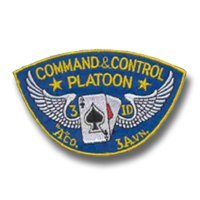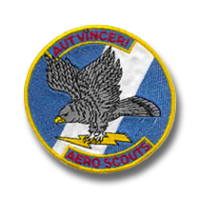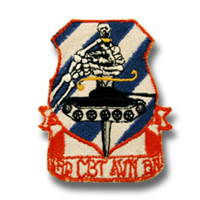If you do NOT see the Table of Contents frame to the left of this page, then
Click here to open 'USArmyGermany' frameset |
3rd
Infantry Division (Mech)
Rock of the Marne
(Page 5 - 4th Brigade & Related Army Aviation Topics)
Looking for more information from military/civilian
personnel assigned to or associated with the U.S. Army
in Germany from 1945 to 1989. If you have any
stories or thoughts on the subject, please contact me . .
|
|
|
|
|
|
| 3rd Infantry Division Aviation Units |
| |
Hq & Hq Co, 4th Brigade
3rd Aviation Company
Detachment C,
3rd S&T Bn
3rd Aviation Bn
3rd Attack Helicopter Bn
13th Attack Helicopter Bn
2nd Bn, 3rd Aviation
2nd Bn, 3rd Aviation
Task Force 23
|
 |
|
|
| 4th
Brigade |
| |
| 1985 |
| (Source: FRONTLINE,
March 22, 1985) |
New Wings
of the Marne
First
in Europe - first in the Army.
New
unit colors were unfurled for the first time March 15, ushering in
a new era in Army aviation. Shortly after two o'clock, the colors
of 4th Brigade (Aviation) were uncased on Giebelstadt Army Airfield
and the unit entered the history books as the first
combat aviation brigade in a division. |
|
|
|
After the colors felt their first brisk wind in Marneland, Maj.
Gen. Howard G. Crowell Jr., division commander, passed them
to the brigade commander, Col. Raymond G. Boland.
The new organization is indeed a "lean, mean, fighting machine."
It combines the old 3rd Aviation Battalion (Combat) and the
3rd Squadron, 7th Cavalry under the control of a brigade headquarters.
Units in the new brigade are a Headquarters
and Headquarters Company; the 3rd
Squadron, 7th Cavalry; the 3rd
Attack Helicopter Battalion; the 13th
Attack Helicopter Battalion; the 21st
Combat Aviation Company; and the 225th
General Support Aviation Company.
The reorganization of the old units was no simple task. In addition
to reshuffling over 1,000 soldiers among units, the cavalry
troopers traded in their tanks and armored personnel carriers
for two troops equipped with Bradley Fighting Vehicles and two
air troops outfitted with AH-1S Cobra gunships. The troopers
and soldiers of the 4th Brigade (Avn) effected the transition
so smoothly that they will serve as examples to future aviation
unit transitions Army-wide.
What the change signifies to the division and to the Army is
that there is now an additional maneuver element providing better
command and control.
The brigade headquarters can accomplish the same tasks as other
brigade headquarters - assisting the division commander in controlling
combat and support units on the fluid modern battlefield. Units
can be attached or detached among the division's four brigade
headquarters to provide more flexibility during battle and to
put combat power where it is most needed. |
|
 |
|
|
| 1989 |
(Source: FRONTLINE, November 24, 1989; 3rd Avn Bn patches are from Alfons
Kraus) |
Marne Legacy
Series
"Wings of the Marne"
By SSgt Edgar A. Stitt
Staff Writer, FRONTLINE
He just can't believe it. Here he is, an officer in the army of the
world's most powerful nation, and he's about to be overrun by World
War II-vintage T-34 tanks driven by a drug lord's mercenaries.
The T-34 is obsolete. But if you don't have the weapons to destroy
it, it's as capable of killing as an M1A1 tank. The M16A2 rifles are
useless against tanks and the platoon's anti-tank weapons had been
fired up. "Maybe we should strap landmines to our helmets and run
out to headbutt the tanks," the lieutenant said grimly to himself.
As the tanks rolled toward his platoon, the lieutenant still can't
believe it was meant to end this way. The radio man is talking to
the command post.
"Those rear echelon guys don't care," the lieutenant thinks bitterly.
All hope is disappearing when the six tanks leading the assault suddenly
explode in a bright ball of fire. The enemy infantrymen, who had been
advancing so confidently a moment ago, hesitated.
Cobra attack helicopters circled, the whine of their engines and twirling
blades drowned out all other sounds. "Fire 'em up!" the lieutenant
screamed. His platoon responded, cutting down the now exposed enemy
infantrymen.
"Sir, we got Blackhawks landing 'bout 50 meters to our rear," a squad
leader jubilantly cried. "We can get outa here "
As the lieutenant watched his men quickly load up on the utility helicopters
he thought, "I guess them guys in the rear do care - thank God for
army aviation."
Army aviation can trace its legacy back to the First World War's air
squadrons. When war swept the world a second time, ground commanders
discovered the importance of having aviation assets directly in their
support.
The Army Aviation Corps of World War II became the United States Air
Force in 1947. As a result, the Army evaluated the development of
its own aviation assets. The U.S. Army's aviation experiment came
of age in 1957 when units were first designated as aviation.
One of these units was the 3rd
Aviation Company, 3rd Infantry Division. This company
was expanded into a battalion in 1963.
Vietnam's demands for men and equipment contributed to the deactivation
of this battalion in 1967. However, in 1972 the 3rd Aviation Company
was resurrected in West Germany and again assigned to the 3rd Inf.
Div.
In 1974, this company was again reorganized into a battalion and designated
the 3rd Combat Aviation Battalion (CAB).
Its mission: "To conduct offensive and defensive operations against
an enemy armored and motorized threat in a mid-intensity environment
as part of the combined arms team and to provide command, control,
and reconnaissance capability for the Division."
 3rd Aviation Battalion DUI 3rd Aviation Battalion DUI
The 3rd CAB spent 1975 serving as a test bed to prove the Army's aviation
concept. Changes in their organization and combined arms and live
fire exercises at major training areas put the finishing touches on
the REFORGER exercise. |
 3rd
Cbt Avn Bn
3rd
Cbt Avn Bn
 A Company,
3rd Avn Bn
A Company,
3rd Avn Bn
 B Company,
3rd Avn Bn
B Company,
3rd Avn Bn
 E Company,
3rd Avn Bn
E Company,
3rd Avn Bn |
|
The
3rd CAB's excellent showing during REFORGER contributed to the
adoption of the aviation concept by the Army. The 3rd CAB became
a "permanent party" unit in the 3rd Inf. Div.
In 1976, the 3rd CAB's choppers demonstrated the lethality of
the TOW anti-tank missile to our NATO allies. An unexpected
gain was the knowledge that the attack helicopter units could
operate effectively in adverse weather conditions.
REFORGER 1977 was the next challenge awaiting the "Wings of
the Marne." In one 24 hour period the battalion was credited
with destroying more than half of the total number of opposing
force vehicles and stopping a major enemy attack. REFORGER 1977
also saw the first airmobile operations in Europe.
The years 1978 and 1979, found the 3rd CAB continuing to grow.
Training missions took them all over Europe to train with various
NATO units.
The 3rd CAB blazed a new trail in designing aviation battalion
combined arms operations in 1980. Another mission given to the
3rd CAB was to be capable of conducting air assault missions.
The battalion participated in many varied exercises in 1980
including the first no-notice gunnery to be held in USAREUR.
During the VII Corps exercise "Certain Rampart" 3rd CAB aircraft
flew 2,527 hours in a fourteen day period.
At the end of the year Company B, 3rd CAB was selected as having
the best company-level partnership program in USAREUR.
The years 1981 and 1982, continued the training exercises and
evaluations. The battalion received the new UH-60 Blackhawk
utility helicopter in 1981.
In 1982 the 3rd CAB was finall consolidated with all all its
units located at Giebelstadt
Army Airfield. Now Giebelstadt is the "hub" of Army aviation
in the 3rd Inf. Div.
The year 1983 saw the 3rd CAB continuing to design and implement
army aviation doctrine. Additionally, they were tasked to support
the 1983 REFORGER exercise.
The history of the 3rd CAB ended on Nov. 16, 1984 when the 4th
Combat Aviation Brigade (Provisional) was activated and the 3rd CAB deactivated.
REFORGER 1984 challenged this new brigade and they rose to the
occasion.
Shortly after returning from successful participation in REFORGER,
the brigade underwent a strenous division Command Inspection
and passed with flying colors.
The activation of the 4th Bde. made it the first combat aviation
brigade in USAREUR.
The 4th Bde. continued to organize and develop this new concept.
In the many different exercises and inspections they have participated
in, they have shown maneuver commanders how important close
air support is.
The 4th Brigade is furthering the Marne Legacy in a new and
different form. They have truly become the "Wings of the Mame." |
|
 C&C
Pltn
C&C
Pltn
A Co, 3rd CAB
|
 Aero
Scout Pltn
Aero
Scout Pltn
A Co, 3rd CAB
|
 B Company, 3rd
CAB
B Company, 3rd
CAB
|
|
|
 |
|
| |
Related
Links:
|
| |
| |
| |
| |
|
 3rd Aviation Battalion DUI
3rd Aviation Battalion DUI







